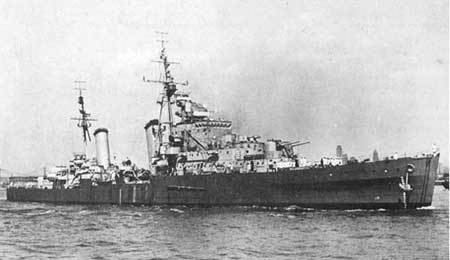Name HMS Phoebe Commissioned 27 September 1940 Out of service 14 March 1951 Launched 25 March 1939 Draft 4.3 m | Laid down 2 September 1937 Decommissioned 14 March 1953 Construction started 2 September 1937 Length 156 m | |
 | ||
Fate Scrapped, Arrived at Blyth on 1 August 1956 to be scrapped by Hughes Bolckow | ||
HMS Phoebe was a Dido-class light cruiser of the Royal Navy. She was built by Fairfield Shipbuilding and Engineering Company (Govan, Scotland), her keel was laid down on 2 September 1937. She was launched on 25 March 1939, and commissioned on 30 September 1940.
Contents

Mediterranean

Phoebe's first six months were spent in the Home Fleet, escorting troop convoys on the first stage of their long voyage via the Cape to the Middle East. In April 1941 she was transferred to the 7th Cruiser Squadron in the Mediterranean. Enemy-held territory here was to keep the British Fleet busy for the next two and half years, and Phoebe was to have her fair share of the action. One of her first operations was the evacuation of troops from Greece and Crete, which was followed quickly by the Syria landings and transporting troops to and from Tobruk, where she was torpedoed by an Italian plane and went to the USA for repair. The damage she sustained put her out of action for eight months.

Phoebe returned to the Mediterranean in the summer of 1942 to escort the last heavily opposed convoy to Malta.
Africa

On 23 October 1942, Phoebe was torpedoed by the German submarine U-161 off the Congo Estuary, while on passage to French Equatorial Africa. Her route was from Simonstown in South Africa to Freetown Sierra Leone, but the ship had to refuel at Pointe Noire. Two U-boats (U-161 and U-126), were patrolling that area at the time.
After the hit, a corvette coming up from the harbour prevented the U-boat from finishing off the cruiser. About 60 crew members were killed (and three more died from malaria in the following days). After provisional repairs, Phoebe made for New York for complete repairs. It was an incredible feat to sail 10,000 nautical miles (19,000 km) with a gaping hole (60 by 30 feet (18.3 m × 9.1 m)) in her hull. The repairs were not completed until June 1943. In October 1943 she returned to the Mediterranean to take part in the Aegean operations.
Far East
In May 1944, Phoebe was transferred to the Eastern Fleet and was involved in strike operations against the Andaman Islands, Sabang in Northern Sumatra and the Nicobar Islands. In January 1945, a busy month, she was switched to supporting amphibious operations in Burma and was engaged in actions against Akyab, Ramree Island off the Arakan Coast, and Cheduba Island. In May 1945, Phoebe was involved in the amphibious assault on Rangoon.
Post war
After VJ-Day, Phoebe returned home for refitting and spent five years in the peacetime Mediterranean Fleet. In early 1948 the cruiser took elements of Royal Marines 40 Commando to Haifa, to assist in the British withdrawal from Mandate Palestine. On 30 June Phoebe embarked the last G. O. C. Palestine and rearguard troops, as the evacuation was completed. After a period in reserve she was sold for scrap in 1956. This brought to an end a relatively short but eventful career.
